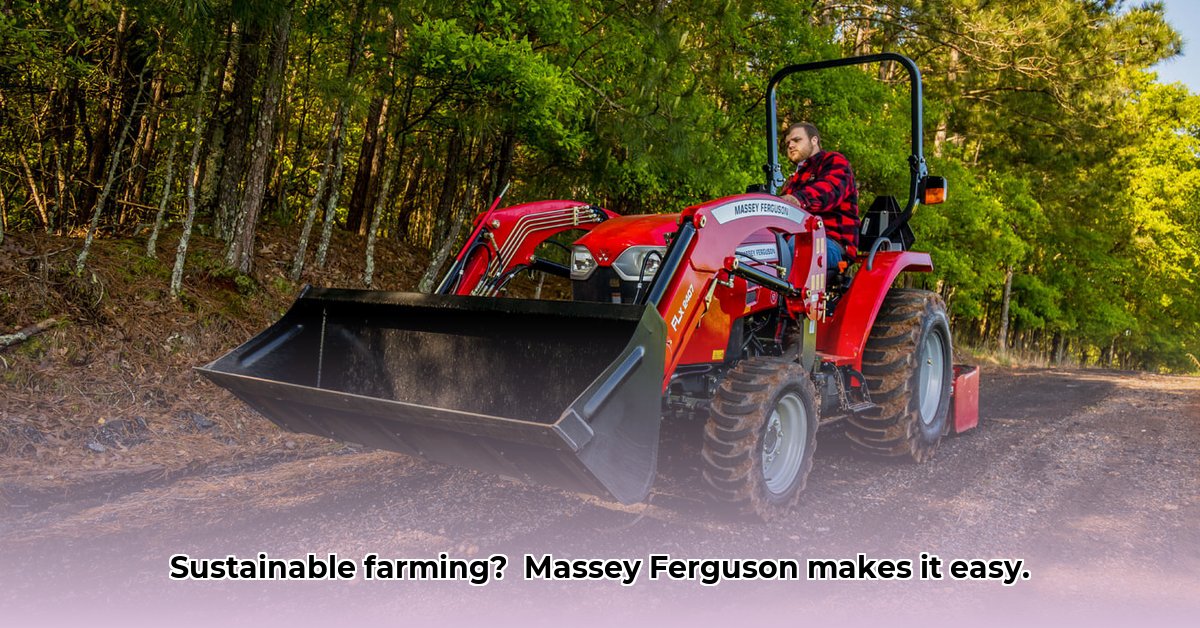
Ready to boost your farm's efficiency and environmental sustainability? Massey Ferguson compact tractors offer a powerful solution for small-scale farmers, but choosing the right one requires careful consideration. This guide provides actionable steps for selecting, using, and optimizing these machines for maximum impact. We'll also address crucial data gaps hindering a full understanding of their long-term sustainability. For more detailed specifications, check out this Massey Ferguson Subcompact Tractor resource.
Choosing the Right Massey Ferguson Compact Tractor
Selecting the ideal compact tractor is paramount to success. This process involves careful assessment and planning. Don't rush this crucial first step!
Step 1: Assess Your Farm's Needs. Begin by honestly evaluating your farm's size (in acres), typical tasks (planting, tilling, haying, etc.), and existing equipment. This foundational step ensures you choose a tractor perfectly matched to your operational demands.
Step 2: Determine Horsepower Requirements. Horsepower dictates a tractor's work capacity. Too little power leads to inefficiency; too much results in wasted fuel. Research the specific horsepower needed for your tasks, factoring in soil conditions and implement weight. Heavier implements and challenging soils demand more horsepower. Remember, choosing the right horsepower directly impacts your operational efficiency and fuel costs.
Step 3: Prioritize Key Features. Essential features directly influence both productivity and sustainability. Consider:
Fuel Efficiency: Look for fuel-efficient engines and technologies designed to minimize fuel consumption and your carbon footprint. Fuel efficiency is crucial for both economic and environmental sustainability.
PTO (Power Take-Off): This is vital for powering implements. Confirm compatibility with your existing or planned equipment.
Three-Point Hitch: This system simplifies implement attachment and detachment, improving both safety and operational efficiency.
Maneuverability: Compact tractors shine in tight spaces. A tight turning radius is invaluable for smaller fields and orchards.
Safety Features: Prioritize safety features like ROPS (Roll Over Protective Structure) and seat belts. Your safety should always be paramount.
Step 4: Budget Wisely. Consider the tractor's initial cost, potential financing options (loans or leasing), and ongoing maintenance expenses. Thorough budgeting prevents unexpected financial strain.
Step 5: Test Drive Before Purchase. Never purchase a tractor without a thorough test drive. Evaluate ease of use, comfort, and overall performance under various conditions. This hands-on experience is invaluable for making an informed decision. A test drive ensures the tractor perfectly suits your needs and operating style.
Optimizing Compact Tractor Use for Sustainability
Sustainable farming practices go beyond mere tractor selection. They encompass mindful operation and environmentally sound techniques.
1. Embrace Precision Farming: GPS-guided technology enables precise application of inputs (fertilizers, pesticides), minimizing waste and maximizing yields. Precision farming significantly reduces environmental impact while improving resource efficiency.
2. Prioritize Soil Health: Minimize soil disturbance through no-till or reduced-till methods using appropriate compact tractor implements. Protecting soil structure improves water retention, reducing erosion and promoting healthy ecosystems. Healthy soil is the cornerstone of sustainable farming.
3. Master Fuel-Efficient Operating Strategies: Maintain proper tire inflation and utilize cruise control where applicable. Consider alternative fuels if your tractor supports them. These seemingly small actions cumulatively significantly reduce your machine's fuel consumption.
4. Implement Regular Maintenance: Regular servicing keeps your tractor running optimally, minimizing downtime and extending its lifespan, ultimately contributing to reduced environmental impact and cost savings.
Data Gaps and Future Research Directions
Despite the growing popularity of compact tractors in sustainable agriculture, substantial data gaps remain concerning their long-term environmental and economic effects. This necessitates collaborative action:
Manufacturers: Collect and publicly share data on fuel consumption, emissions, and operational efficiency.
Government Agencies: Establish standardized metrics for measuring the environmental sustainability of agricultural machinery.
Research Institutions: Conduct comprehensive lifecycle assessments (LCA) to provide a complete understanding of environmental impact from production to disposal.
Resources and Further Reading
- Link to relevant government agency (e.g., USDA)
- Link to research institution focused on sustainable agriculture
- Link to a reputable agricultural publication
This guide provides a strong foundation for leveraging Massey Ferguson compact tractors in sustainable farming practices. By combining informed equipment choices with mindful operation and collaborative research, we can drive towards a more efficient and environmentally responsible agricultural future.